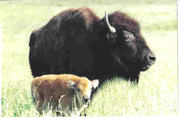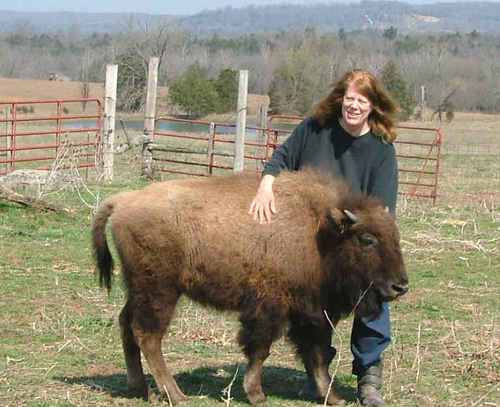Custom 3
Learning About Buffalo
Learning about buffalo has been a never ending quest for me (Carol) ever since we decided to raise buffalo. It has taken us to many new and interesting places and events, and brought us countless new friends. I will never reach the point, thank goodness, when there is nothing new to learn about my woolly friends.
Sharing the things that I have learned about buffalo has become another special pleasure for me. I am glad you have joined me on this page, and would love to tell you some of the things that I have learned. To tell you what life is like for buffalo on the farm, BUFFALO TODAY is a story that I wrote for the Missouri Bison Association cookbook, COOKING WITH AMERICAN BUFFALO. I hope you enjoy it.
Buffalo Today
The newborn buffalo struggled to stand on wobbly legs, then flopped back down. His mother grunted encouragement and gave him a few happy licks with her long tongue. Once again he made a mighty effort and stood swaying. He had a great inward urge to find his mother's udder, where ever and what ever that was. After minutes of exploring his mother's underside, his search ended. The happy wagging of his tail told the world that this was worth the effort.
Members of the herd came to check out the new arrival, then went on with their eating. Curious calves gathered nearby. The new babe was fascinated with these little beings who were just his size and who seemed so friendly. When his woolly coat dried off, it would fluff up like theirs, and be the same soft pumpkin color. Soon he would be spending as much time with them as he did with his mother, playing, exploring and tasting every plant in sight.
The days of summer grew longer, and then shorter again. The hair along the calves' back and around their eyes turned brown. Before long they lose all the orange baby color, and take on the buffalo brown of their mothers. Horns are now an inch long on the little bulls, and while visable are more delicate on the heifer babes. The herd bull is now courting the mother cows in their rutting season, making babes for the following spring.
With the coming of fall, the adult bison begin to grow a winter coat to protect them from the cold. They look like they are covered in velvet, then gradually a thick, woolly fur covers their bodies. The whole herd loves the crisp, cool days of fall. They thunder across the pastures in a full run or a bonging hop, for the joy of being alive and being buffalo. The calves now have a distinct hump. This bony protrusion from the backbone above the shoulders is an anchor for their strong neck muscles,enabling them to plow away snow for winter grazing. Winter cold will be pleasant for them, rather than a hardship. Their bodies adapt to the season by lowering their metabolism. They will not eat as much during winter and will grow little until spring.
Soon it will be time for the calves to be removed from their mothers. Most farms are small, and cannot keep these additional animals in their herds. Many of the babes are already spoken for, contracted by other farmers to expand herds or form new herds. The remainder will be taken to auction, or pastured together until sold or taken for meat.
As spring comes once more to the farm, the babes have become yearlings. Their horns and legs are growing longer and they take on the awkward, charming look of adolescents. It is a happy, carefree year for these young buffalo. Their job is to eat and grow, and enjoy life. They are very sociable animals, staying in a group virtually all the time. Yet they have developed strong individual personalities and a "pecking order" within the herd.
By the time these young bison reach their second birthday, they have matured into breeding age buffalo. Depending on their sex and genetics, they now weigh between 700 and 1,000 pounds. They will not reach their full size and maturity until they are seven years old when they can double their two year old weights. The two year old heifers will be placed in a breeding herd, as they will join in the rut this summer. Only the very biggest and best of the two year old bulls will join a breeding herd. These buffalo can live to twenty and even thirty or more years of age. Buffalo cows in good condition will calve every twelve months,and twenty calves is not unreasonable to expect from these mothers.
If bulls are not placed in the breeding herd, they will become meat animals before their third birthday. This young age will help insure the tenderness of the meat. Farms differ on how they feed these bulls to prepare them for slaughter. On some farms, they remain in the breeding herd, feeding on grass, until they are required for meat. Other producers prefer to finish the bulls on grain for a few months to maintain a control over the taste of meat as grass differs according to season, pasture, and weather. These animals will be separated into a meat herd and fed grain on pasture, or placed in confinement to be fed. Although life is shorter for these bulls, it has been good. And their meat is not wasted, rather it provides nourishment so that humans can live and be healthy. This meat provides the necessary financial support for their herd and farm home to prosper.
When buffalo roamed these lands, wild and free, they adapted to their environment and multiplied into the millions of animals. Nature was not always kind. Blizzards, range wild fires, and droughts made life very difficult at times for the buffalo. The strongest animals survived, bred, and continued to multiply. It is no longer possible for buffalo to roam freely across this country. Farmers and ranchers, who admire the buffalo and chose to raise them, take on the responsibility of seeing that fenced herds are well fed, healthy, happy and safe. It is also their job to choose which animals will survive, breed and multiply. Raising buffalo is a challenging and very rewarding job. It requires planning, understanding, and a lot of patience rather than strength and physical work.
A buffalo is well fed when he is grazing on properly managed grass pastures. Grass hay is substituted when the pastures are dormant.The farmer must make sure that there are no more animals than the land can sustain. This can be challenging, as weather differs from year to year. Keeping the grass from over maturing or being over-grazed requires flexibility and close watch over the fields. If this job is well done by the farmer, the buffalo will enjoy a longer season on good grass and will require less expense for hay.
A well fed buffalo is a happy buffalo, if he also has the company of a herd. They do not like to be alone. This can make it difficult to sort animals from the herd when necessary to do so. They always want to stay together, and even more so when they feel threatened. Traditional protection for the buffalo has always been safey in numbers. Stronger animals will protect the herd from danger. These animals can out run horses, jump, kick, and use their horns very expertly. If the buffalo are not happy, they will be very difficult to keep in any pasture. The farmer definitely wants his buffalo to be very happy.
A well fed, happy buffalo is a very strong, healthy animal. There are diseases which can spread from neighboring beef herds to the bison. Because of the sturdiness of the bison this rarely happens. But most farmers will vaccinate at least the calf herd against bovine disease as a precaution against the stress of weaning. Whether or not the animals are vaccinated, the farmer keeps close watch on the physical condition of his herd, watching for any signs of poor health. The one weakness a buffalo has is a lack of resistance to stomach worms. Because they are now confined to a pasture, rather than roaming a wide prairie, they are exposed to these intestinal parasites. The farmer must medicate against this health problem a couple of times a year, or his animals will not survive. It is that important. Farms that attempt to meet organic standards with buffalo can face disaster from this source. Buffalo are normally raised as Natural rather than Organic for this reason.
Keeping buffalo safe is a matter of keeping them in their pasture. Fencing cannot be taken for granted with a herd of buffalo and gates must be kept closed at all times. An escaped buffalo is a danger to traffic and property. He is in danger from those who protect life and property of people. Having good fencing and working equipment is an expense required by farms choosing to raise buffalo. Keeping hunters and dogs out of pastures can prevent problems from occurring. A younger buffalo herd may run from intruders, while a mature herd might well run after them.
There are two sayings about buffalo that are very true: "You can chase a buffalo anywhere he wants to go." and "You can make a buffalo do anything he wants to do." The farmer must first decide what needs to be done, then figure out how to make the buffalo want to do it. Giving grain to a buffalo is like giving ice cream to a kid. They didn't evolve eating it, and too much of it is not good for them - but they sure do love it! By giving the buffalo treats of sweet grain or range cubes, the farmer teaches the buffalo to come to him when he wants them. This is a lot easier than going out to "round them up". With proper planing, managing buffalo can be fairly easy.
Most farms slaughter at least some animals for food each year. Some of these are being culled from the herd as inadequate mothers, but most are excess young bulls whose job it is to support the farm. This meat may be available to friends, neighbors, and family who buy a quarter or side of the animal. Word of mouth is usually how news of this meat is spread. The farmer may occasionally advertise meat if he has excess animals.
In order to sell meat in retail cuts at farmers markets, health food stores, grocery stores, and restaurants, the animal is slaughtered at a USDA inspected plant. This can be a very expensive process, and can add substantial costs to the price of the meat. It is frequently an all day trip to take the animals to that plant, and another trip two weeks later to pick up the meat.
Buffalo producers must pay for the USDA inspection, currently at $44 per hour, although this service is provided free by the government for beef, pork, and chicken. The transportation costs, time of travel, and cost of inspection can add well over a dollar a pound to the meat, even before considering the costs of the actual process of slaughter, hanging, and wrapping. This is considered the cost of keeping America's food supply safe, and is more important than ever in today's world.
While the outstanding health properties and taste qualities of the buffalo meat cannot be matched by any other meat, possibly the most precious contribution that buffalo brings to the consumer, is the opportunity to know these wonderful American animals and the farmers who raise them. The relationship between farm and consumer has been lost in today's society. They are being brought together again by the American Buffalo.

